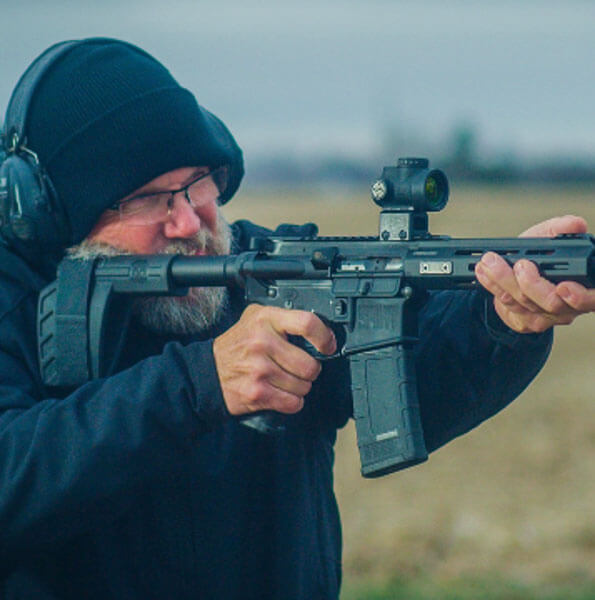SBR Episode I: Short-Barreled Rifles – A Short Crash Course
July 7th, 2019
3 minute read
In the early days of firearms development (beginning of the 15th century), the [extremely condensed and incomplete] discovery / invention timeline looked something like this:
- Rifling
- Wheel lock
- Flintlock
- Pin-fire
- Rimfire
- Centerfire
Short Long-Gun History
The development occurred over a span of nearly five centuries. However, once centerfire cartridges were introduced in 1869, Winchester produced the first center-fire rifle within three or four years.
And rifle development and purchases / ownership rocketed from there.
Many rifles were engineered with v-e-r-y long barrels. These long barrels were needed to help develop higher velocity (due to the limits / slow burning rates of the available propellents at the time). However, these long long-guns were very cumbersome to manipulate and shoot.
A demand eventually developed for smaller rifles that were easier to handle. To make those rifles or muskets lighter and more compact, the obvious approach was to shorten both the stocks and the long barrels.
Though a modification as such would definitely result in lower velocities of the projectiles, and therefore lower power, the trade off was much greater maneuverability. And if this new, smaller rifle could still produce acceptable levels of power, it would be deemed a worthwhile trade.
Carbine Creation
Thus was born the “carbine,” a shorter version of a full-length rifle, that fires the same type / caliber of ammunition.
And as the development of propellents progressed and long barrels were no longer required to achieve the desired ballistics, the next logical step was to develop even shorter barrel lengths – to gain even greater maneuverability and usability.
Birth of the Short-Barreled Rifle (SBR)
And so began discussions, designs, testing, redesigning, further testing, and finally production of SBRs.
The primary design focus of the Short-Barreled Rifle was to create the most compact, light and maneuverable shoulder-fired firearm possible. As we know, the easiest way of reducing the size and weight of a rifle (simultaneously making it more compact) has always been to shorten the barrel. So that’s what was done.
To summarize, we have covered:
- The original, unrestricted long-barreled rifles
- The unrestricted shorter-barreled carbine rifles
- The restricted short-barreled rifles, known as SBRs
Notice I say restricted, as that is a very important qualifier.
Government & Guns
In the early 1930s, Congress became motivated to tax the production, transfer, importation, etc. of a certain class of firearms. This act was known as the National Firearms Act or NFA.
From the ATF.gov‘s NFA web page:
“The NFA was originally enacted in 1934. Similar to the current NFA, the original Act imposed a tax on the making and transfer of firearms defined by the Act, as well as a special (occupational) tax on persons and entities engaged in the business of importing, manufacturing, and dealing in NFA firearms.
The law also required the registration of all NFA firearms with the Secretary of the Treasury. Firearms subject to the 1934 Act included shotguns and rifles having barrels less than 18 inches in length, certain firearms described as “any other weapons,” machine guns, and firearm mufflers and silencers.”
NFA Firearms include (not an inclusive list):
- Machine Guns
- Short-barreled Rifles (SBRs)
- Short-barreled Shotguns
- Silencers
- Destructive Devices (grenades, bombs, etc.)
https://www.atf.gov/rules-and-regulations/national-firearms-act
The barrel length was later amended to 16 inches (vs. 18 inches) for centerfire rifles.
So what does all of this legal jargon mean to the consumer?
Get Wise Before You Buy
As with any firearm activity (the purchase, sale, transport, traveling with, carrying of, etc.), the onus is on YOU to check local, state and federal laws regarding the specific firearm activity. Don’t ever take someone else’s word for it when dealing with firearm regulations.
And before buying an SBR, you need to do the same. It’s extremely important that you get it right, as SBRs are an NFA firearm and are therefore stringently regulated by the government.
To summarize, the federal law states that to buy / build an SBR, you must pass stringent background checks and pay additional fees. You must also register SBR devices.
In short, it is much more complicated than buying a NON-NFA firearm. However, many gun owners are more than willing to go through this process.
But Why Bother?
So why would anyone go through the additional steps to own an SBR?
Because they are very practical, usable, powerful, maneuverable and more importantly, extremely “cool” guns.
These are the primary reasons they are so popular among civilian enthusiasts, and the LE and Military world.
And as with all things cool, there are pros and cons. To find out more about SBRs, check out the next articles in this series by Team Springfield Captain Rob Leatham, SBR Episode II: Short-Barreled Rifles – Worth The Work!
Join the Discussion
Continue Reading
Did you enjoy this article?

 56
56






